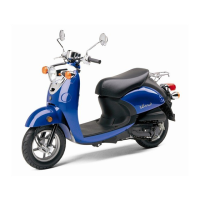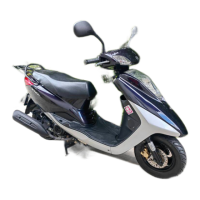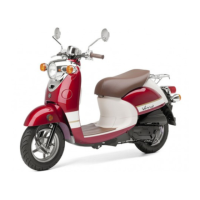Do you have a question about the Yamaha VERSITY 300 VP300 and is the answer not in the manual?
Essential riding practices and precautions for safe operation.
Guidelines on wearing appropriate safety gear to prevent injuries.
Warnings against unauthorized modifications and their safety implications.
Advice on safely adding accessories or cargo to maintain stability.
Safety precautions related to fuel handling and exhaust fumes.
Additional tips for safe riding in various conditions and situations.
Illustrated identification of major components on the left side of the scooter.
Illustrated identification of major components on the right side of the scooter.
Detailed overview and labeling of the scooter's dashboard controls and instruments.
Operation of the ignition switch and steering lock mechanism.
Explanation of dashboard warning and indicator lights.
Function and display of the vehicle's speed indicator.
How to read the fuel level and the function of the fuel warning light.
Monitoring battery voltage and engine coolant temperature.
Features and modes of the digital display including odometer and tripmeters.
Displays ambient temperature and frost warning indicator.
Notification for scheduled engine oil changes and reset procedure.
Information on the optional anti-theft alarm system.
Operation of various switches located on the handlebars.
Location and operation of the front brake control lever.
Location and operation of the rear brake control lever.
Procedure for removing and installing the fuel tank cap.
Recommended fuel type, tank capacity, and refueling precautions.
Information about the catalytic converter and related precautions.
Instructions for opening and closing the scooter seat.
Details on accessing and using the front storage compartments.
Details on accessing and using the rear storage compartment.
Location and purpose of the housing for a U-LOCK.
How to adjust spring preload for suspension tuning.
Location and load limits for the luggage hook.
Operation and safety warnings related to the sidestand.
Explanation of the system that prevents starting or stops the engine.
How to use the 12V accessory power outlet.
Essential checks to perform before each ride for safety and performance.
Step-by-step guide for starting the scooter's engine safely.
Procedures and precautions for moving the scooter from a standstill.
How to control speed using the throttle grip.
Proper techniques and warnings for applying the brakes.
Advice on economical riding habits to improve fuel efficiency.
Guidelines for the initial period to ensure proper engine longevity.
Safe procedures and precautions for parking the scooter.
Location and purpose of the included tool kit for basic maintenance.
Schedule and tasks for regular servicing and lubrication.
Instructions for safely disassembling and reassembling body panels.
Procedure for inspecting the spark plug and its condition.
How to check and change the engine oil, including quantities and types.
Procedures for checking and changing the final transmission oil.
How to check and maintain the engine coolant level.
Maintenance procedures for air filter elements.
Recommendation to leave carburetor adjustments to a dealer.
How to check and adjust throttle cable slack.
Information that valve clearance adjustment is a dealer task.
Guidelines for tire pressure, condition, and replacement.
Information regarding inspection and maintenance of cast wheels.
How to measure and check brake lever free play.
Procedure for inspecting brake pad wear.
How to check the brake fluid level and its importance.
Information that brake fluid changes are dealer tasks.
Maintenance of control cables for smooth operation.
Maintaining the throttle grip and cable.
Lubrication points for brake lever pivots.
Maintenance of the centerstand and sidestand.
Inspection of the front fork for damage and oil leaks.
Procedure to check for wear in steering bearings.
How to inspect front and rear wheel bearings.
Information about the sealed battery and charging precautions.
Procedure for replacing blown fuses and fuse specifications.
Step-by-step guide for replacing the headlight bulb.
Instructions for replacing front turn signal bulbs.
How to replace tail, brake, and rear turn signal bulbs.
Procedure for replacing the license plate light bulb.
Introduction to diagnosing and resolving common scooter problems.
Diagnostic flowcharts for starting issues and poor engine performance.
Steps to take if the engine overheats, including coolant checks.
General guidelines for cleaning and maintaining the scooter's appearance.
Detailed instructions and precautions for cleaning different parts of the scooter.
Procedures for short-term and long-term storage to protect the scooter.
Location and recording of key, vehicle, and model identification numbers.
| Fuel System | Fuel injection |
|---|---|
| Transmission | Automatic CVT |
| Front Suspension | Telescopic fork |
| Rear Suspension | Unit Swing |
| Front Brake | Single disc |
| Rear Brake | Single disc |
| Displacement | 292cc |
| Fuel Delivery | Fuel Injection |
| Starter | Electric |
| Tires Front | 120/70-14 |
| Fuel Capacity | 12 L |
| Final Drive | V-belt |
| Tires Rear | 140/70-14 |
| Engine | Single cylinder, 4-stroke, SOHC, 2-valve |
| Engine Type | Single cylinder, 4-stroke, SOHC, 2-valve |











